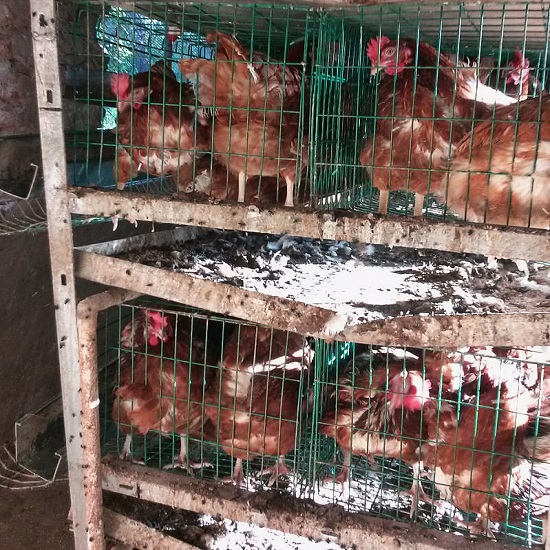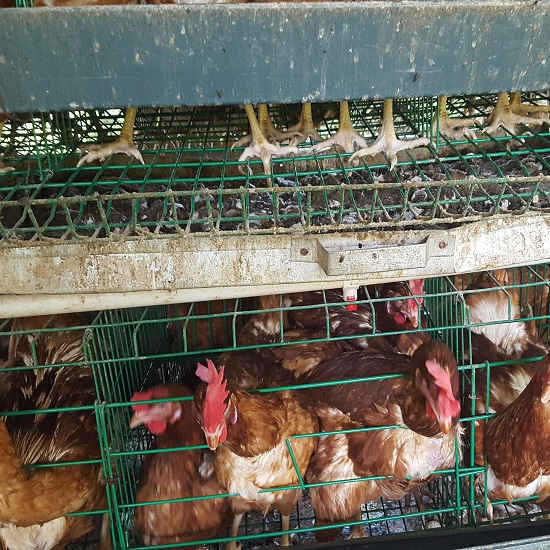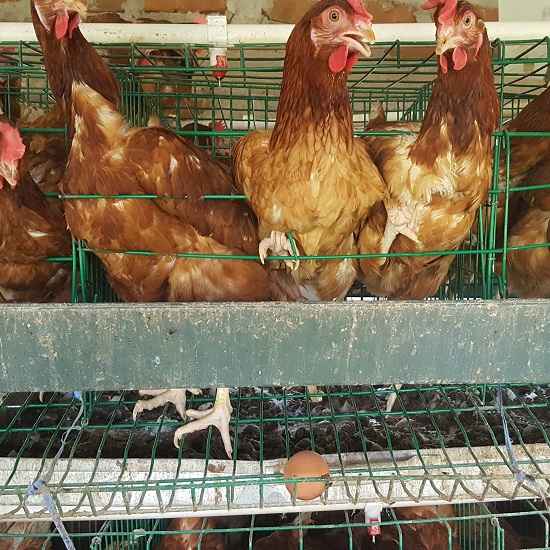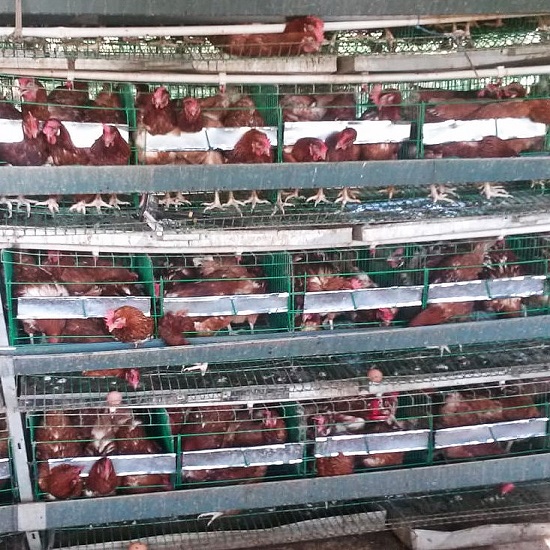Poultry Industry in Africa.
The Problems we aimed to Address is to support the Development of the Poultry Industry in Africa. Primary obstacles to the Growth of the Poultry Industry are:
The high cost, poor quality / design of the cages that must be imported by the trailer load from China at cost of 14,220.00 US for (80) sets.
These designs have generally been geared towards maximum profit without consideration for best space utilization, sanitation, structural stability, longevity and environment for the healthy and productivity of the Chickens.
Chicken Battery Cage System.
These designs have generally been geared towards maximum profit without consideration for best space utilization, sanitation, structural stability, longevity and environment for the healthy and productivity of the Chickens.
We designed, patented and produced the first Kenyan made commercially viable Chicken Battery Cage System. Our invention introduces a new efficient system for providing the effective space needed for individual cages for four birds to comfortably feed and get the required volume of food to produce a steady supply of high-quality eggs without being stressed by overcrowding.
Why we took on this, venture our aims and goals
After learning, that Kenya’s Poultry Industry produces a billion birds annually and that All the Cages were being imported from China and are of inferior quality. We were inspired to design and produce: The first Kenyan made commercially viable Chicken Battery Cage System. Our system will provide hundreds of new jobs support numerous local industries and facilitate industry growth. My Goal is to radically change the economic dynamics of this industry by providing suppliers the ability to be producers of our unit in quantity and on demand.
The benefits and opportunity our system provide: We can license and train companies to produce their own unites in the most efficient manor to meet the needs of the industry. This eliminates the necessity of suppliers investing huge amounts of capital that is tied up for many months before they can begin to see any return. My system will also stop the dependency on substandard Chinese imports that require:
Huge cash investment and wait three months for shipping, clearing. Local transport taxes and VAT. Verses earning interest and making more lucrative investments with our capital. Rental of large Go-downs for storage and wait another 3 – 6 months for the dead inventory to sell then to start this vicious cycle again.
Potential Industry impact and benefits.
Two of the primary obstacles in the growth of his industry are:
The high and uncertain cost and quality of the primary food protein ingredient (omena). The high cost, poor quality / design of the cages that must be imported by the trailer load from China. Tosheka Products has two interventions that address these obstacles. A new efficient system for providing the effective space needed for individual cages for four birds to comfortably feed and get the required volume of food to produce a steady supply of high-quality eggs without being stressed by overcrowding.
We produce Eri Silk which is a farming activity and one of its buy products is pupa that is 70 % of the cocoon weight and is a high protein nutritious alternative protein chicken feed. Eri Silk pupa has numerous benefits as an alternative protein source over omena. Here provide a link to the file called “Chicken Feed & use of Pupa””
Providing 1/3 more space in the individual cages which provides adequate space for four birds to comfortably feed and get the required volume of food to produce a steady supply of high-quality eggs without being stressed by overcrowding.
The Cage System requires approx. half of the floor space as the standard A frame unit and this provides an opportunity for twice as much production and output in a given area. Designed and built to guarantee 20 years of service.
Details of our product design, construction & benefits
The Cage System has a steel beam system that independently supports every level of cages to provide structural stability, longevity. The current cages have no independently supports at every level of cages to provide structural stability and therefore the cage system collapse in the center after a few years of use because all the levels are pressing down on each other.
The current cages all the chicken waste is dropped on the floor beneath the cages. This causes rats, snakes and fly’s to be drawn to the cages which can kill the birds and contaminate eggs. The Cage System has individual catchment pans which are easily removed and leaned which eliminate the waste being deposited on the floor and drawing pest
The Cage System is designed to accommodate 120 or 160 layers comfortably while maximizing space utilization. The Cage System is constructed of a steel support frame and the cages are made of PVC covered metal mesh and individually supported but the steel frame system. The cages are installed back-to-back and can easily disassembled transported and reassembled.
Our cage system comes preassembled ready for transport and installation and can be quickly and reassembled within ½ hr. Our support stands are built to accommodate either three or four tiers of cages and gives the poultry farmer the option of increasing from 3 -4 tries and increasing capacity at a later date without a requiring any additional space. At any time, you can expand your productivity by adding on cages to the length of our existing system. Our mesh of battery cages system ensures your chicken cage a long use service and no rust easy cleaning. With our system farmers can Increase your profitability within your current space and save the need for building expansion.
Letter of Support: see a place letter of support. The Case for Eri Silks benefit to the Textiles, Chicken Feed and Human Nutrition Industries. Eri Silk Pupa Summary & Benefits as a Protein Alternative to Omana
Contact Herman Muli Bigham hblj2@aol.com
254-733-368-880
Letter Of Support
Tosheka Textiles:
We received a letter from Ministry of Industrialization, Trade and Enterprise Development Office of the Chief Administrative Secretary, Mr. Lawrence Karanja expressing a commitment
to the growth and sustainability of the Silk industry. We are confirming our meeting in Wote on March 24th. and providing you with information on:
The Case for Eri Silks benefit to the Textiles, Chicken Feed and Human Nutrition Industries
Click here for the accessible version
Re: Tosheka Textiles The case for textiles, chicken feed , and human nutrition
Thu, Mar 18, 2021 8:04 am
Dickson Kibata (dkibata@yahoo.com)To:you Details
Dear Bigham
Hi
I have gone through the write up and it is impressive. It is our policy to promote innovation like this one and I assure you of our support.
I look forward to visiting you in the near future.
Dickson Kibata
Technical and Advisory Services
Fibre Crops Directorate
Agriculture and Food Authority
Eri Silk Pupa Summary & Benefits as a Protein Alternative to Omena
Eri Silk Pupa Summary & Benefits as a Protein Alternative to Omena. According to Ms Wairimu Kariuki, the chairperson of Kenya Poultry Farmers Association (Kepofa), the industry is likely to report a 30 per cent drop in production and incur heavy losses because most farmers have reduced the number of chicken they are rearing.
Business Daily reports that Ms Kariuki said: “Chicken feed accounts for 70 per cent of the total input cost so if the feed prices goes up, the input-costs will automatically increase. If a farmer cannot meet the costs, he chooses to either reduce the number of chicken he rears or stop poultry farming altogether.”
The industry now fears that if farmers continue to reduce the number of chicken they are rearing, by the end of the year there might not only be a scarcity of poultry products but also increased prices on poultry products.
Eri silkworm (Samia ricinii) is a traditional source of food in northeast India, where it is grown primarily for silk and food uses. For the tribal people in NE India, the eri pupa is considered a delicacy, whereas the cocoon is more or less a by-product. Nutrient analysis showed that the proximate composition of eri silkworm prepupae and pupae grown on either castor or tapioca were comparable and it was a good source of protein (16 g %), fat (8 g%) and minerals. The amino acid scores of eri prepupae and pupae protein were 99 and 100, respectively, with leucine as the limiting amino acid in both cases.
Net protein utilization (NPU) of prepupae and pupae was 41 as compared to 62 in casein. Protein digestibility corrected amino acid score (PDCAAS) was 86. The high protein content in the defatted eri silkworm meal (75%) with 44% total essential amino acids makes it an ideal candidate for preparing protein concentrate isolates with enhanced protein quality that can be used in animal nutrition.
Experimental study has shown the pupae to be suitable as a high protein substitute for fish meal in chick diets. Eri silk is an ideal example of sustainable agriculture, which produces silk and a pupa that is a high-protein food or animal feed, and the caterpillar and other rearing residues can be used for fishpond culture. The by-products of the eri rearing are often used as fertilizer for agricultural production. Silkworm pupae have been used in Chinese traditional medicines since ancient times.
Pharmacological studies have shown that silkworm pupae increase immunity, protect the liver and prevent cancer. Proximate analysis of pupa has shown that it contains 55–60% protein, 25–30% lipid, 4.96% fibre, and other substances, e.g. hormones, trace elements and vitamins, thus indicating that it could be a good protein source for various purposes4,5. Analysis of pupa Philosoma ricini (eri silk) showed high moisture content (74.66%), protein (18.44%), lipid (4.24%) and ash (1.58%). Live larvae are sold in markets for up to INR 160/ kg (USD 2.55/ kg ) in North-East India. The delicacies are roasted, fried, or boiled before consumption. The Eri silk is quite popular within the Jain community in India were it can fetch Rs 300 to Rs 500 per kilogram.
The Case for Eri Silks benefit to the Textiles, Chicken Feed and Human Nutrition Industries
The Case for Eri Silks benefit to the Textiles, Chicken Feed and Human Nutrition Industries
Tosheka Products new design for Egg Layer Battery Cage Systems
The Corona experience has stimulated new interest and activity in poultry farming. The two primary obstacles to the national growth of this industry are:
The high and uncertain cost and quality of the primary food protein ingredient (omena).
The high cost, poor quality / design of the cages that must be imported by the trailer load from China at cost of 14,220.00 US for (80) sets.
Tosheka Products has two interventions that address these obstacles.
We designed, patented and produced first Kenyan made commercially viable Chicken Battery Cage System. The present invention introduces a new efficient system for providing the effective space needed for individual cages for four birds to comfortably feed and get the required volume of food to produce a steady supply of high-quality eggs without being stressed by overcrowding. (See attached details)
We produce Eri Silk which is a farming activity and one of its buy products is pupa that is 70 % of the cocoon weight and is a high protein nutritious alternative protein chicken feed. Eri Silk pupa has numerous benefits as an alternative protein source over omena.
Because of the uncertainty of the quality and composition of pre-ground fish meal mills are forced to buy the raw fish product, examine it’s content to assure that it does not contain fillers, or was contaminated in processing.
Silk Pupa quality, content and supply is consistent and is free from Salmonella, Melamine and Ecoli. Also, the energy and protein calculation of Silk Pupa are higher on average than fish meal.
A natural proven protein supplements that have been utilized successfully in numerous countries.
Also, there can be significant variation in availability (absorption and retention) of amino acids due to the day to day variation in inputs as well as processing conditions (temperature, moisture, pressure and time). Protein digestibility corrected amino acid score was very high (PDCAAS) was # 86.
Pharmacological studies have shown that silkworm pupae increase immunity, protect the liver and prevent cancer. Proximate analysis of pupa has shown that it contains 55–60% protein, 25–30% lipid, 4.96% fibre, and other substances, e.g. hormones, trace elements and vitamins, thus indicating that it could be a good protein source for various purposes.
Tosheka Textiles LLC. has the only license to commercialize Eri Silk and our silk production produces a high volume of pupa. We have now begun to collaborate with a feed suppler to develop, formulation and testing utilizing our pupa to support the quality and price stabilization of the protein content of poultry feed in Kenya.
Our broad range of activities provide mass employment opportunities and this is an additional rationale for the National Government to provide a full system of resource and funding for the full-scale production of Eri Silk farming and Textile development.
The Scope, income and impact of our Alternative Silk / Protein Business provides four major revenue streams.
Tosheka is the leading Eri silk producer in East Africa and has introduced a new breed of silkworm that can survive dry conditions which provides a desperately needed alternative textile fiber (Eri Silk) and a superior source of Alternative protein. Eri silk production provides four major revenue streams i.e textiles, protein foods, castor oil and fertilizers. It will also create massive employment, numerous health and environmental benefits. Alternative Protein is the leading area of Agri-Business funding.
The pupa alternative protein production project will start out focusing on making our nutritional supplement for local and Refugee consumption. Secondarily we will work with local flour and baking companies to have our nutritional product added to their products. Thirdly we would then partner with local food product producers to use the pupa as a nutritional supplement to make a series of baked products and protein bars.
The next stage would be reaching out to international companies that are producing Alternative food products to partner with them on supplying our protein products and raw protein to develop new products and Soybeans alternatives
Our Eri Silk production provides large amounts of pupa, which is a unique, nutritional clean source of inexpensive non-meat high protein that affords us (12) twelve income streams, massive employment for farmers and numerous health and environmental benefits. We are in the process of scaling up our silk production to supply contracted demand and pupa for production of your current and future product development and seeking partnership and funding. We have large, confirmed orders for our silk yarns & cocoons from a Japanese buyer.
We are ready to provide a full detailed proposal at your request which describes this development initiative and it’s support of multiple sections of Vision 2030.
Lucy & Herman Bigham
0733-368-880

















